Optimizing Electric Vehicle Operations for a Smart Environment: A Comprehensive Review
Abstract
1. Introduction
2. Background
- Steam engines;
- Internal combustion engines;
- EVs.
- Battery EVs (BEV);
- Plug-in hybrid electric vehicle (PHEV).
- Level 1;
- Level 2;
- DC fast charging.
2.1. Communication System
2.2. Investigating the Effects of EV Integration with the Grid
2.3. Connectors
- They are waterproof.
- Some of them will be able to perform the charging operation in three phases.
- They usually have an electronic or mechanical immobilizer, and when this immobilizer system is activated, the EV will not be able to move.
- The required amount of energy will be provided when the electrical or mechanical locking system is active.
- AC pin, with two-phase and neutral pins to supply the energy required for EV batteries;
- The system of connecting the electrical system to the ground;
- User control, which allows communication with the vehicle.
- Model 1, known as SAE-J1772-2009, is used to find a standard and optimal interface in the SAE-J1772 and IEC-62196-2 standards. According to Part A of Figure 5, this model is commonly used in EV charging equipment in Japan and North America.
- According to part c of Figure 5, the second model is known as VDE-AR-E 2623-2-2, which is limited to 230 volts in single-phase mode. This model consists of seven pins as follows:
- ▪
- Four pins for three-phase mode;
- ▪
- A pin for ground connection;
- ▪
- Two more pins to connect with EVs.
- According to part e of Figure 5, model 3, known as EV Plug Alliance, is a single-phase and three-phase connector. These connectors provide 230 V/400 V voltage and 16 A/63 A current. Model 3 was proposed in Italy and France for EV charging equipment, but due to the poor reception of this model, the production of these connectors has been stopped.
- Finally, according to part f of Figure 5, model 4, which is known as (EVS G105-1993) CHAdeMO, is used more in Japan compared to Europe and North America. This connector model provides a voltage of up to 400 volts and a current of 200 amps for the fast charging of EV batteries. In addition, this interface in its early versions and a power supply of 150 kW was designed for now, but now the goal is to supply power up to 350 kW. This connector has 10 pins as follows:
- ▪
- Two pins for the power supply;
- ▪
- One pin for ground;
- ▪
- Another seven pins to connect to the power grid.
- First type of connector for AC charging;
- Second type of connector for DC charging.
- Sale in Europe according to part c of Figure 5;
- Sales in the United States according to part h of Figure 5.
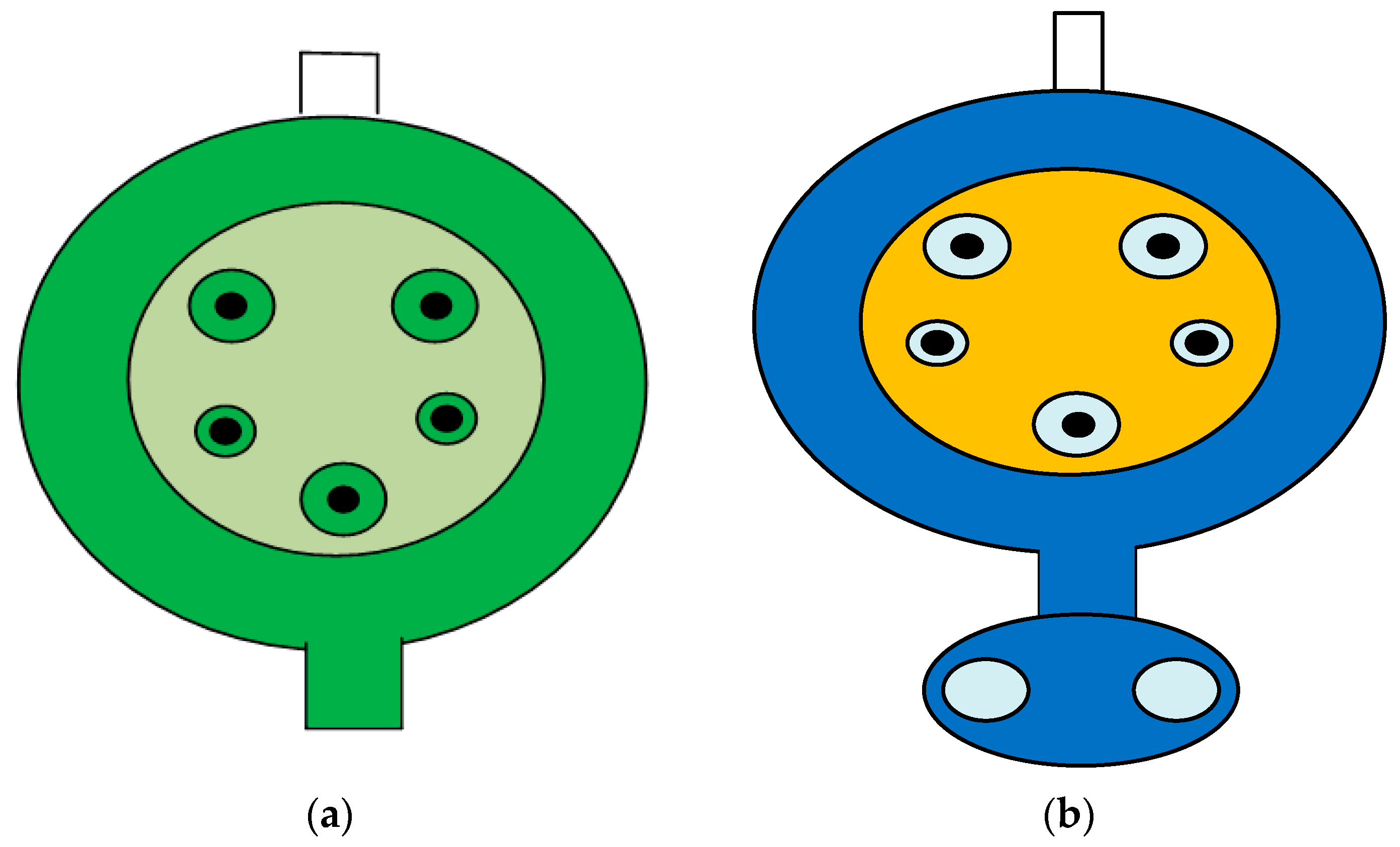
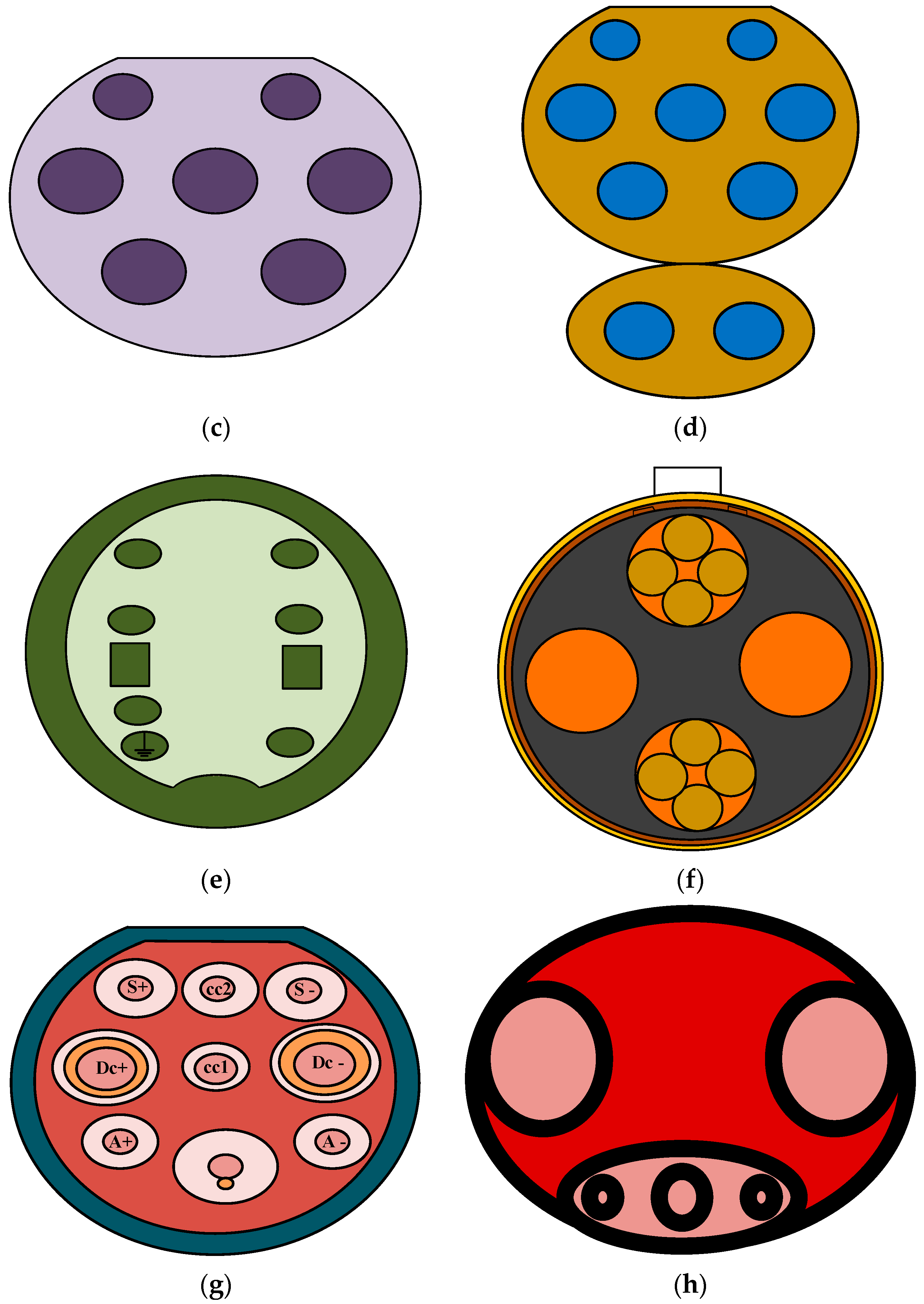
3. Charging Methods
- Dumb charging;
- Smart charging;
- Flexibility charging;
- Smart charging model for V2G.
3.1. Dumb Charging
3.2. Smart Charging
3.3. Smart Charging Model for V2G
3.4. Flexibility Charging
4. Control Methods of EVs
4.1. Deterministic Control Model
4.1.1. EV Charging Based on a Centralized Model
4.1.2. EV Charging Based on a Decentralized Model
5. Battery Technology
5.1. Lead–Acid (Pb-PbO2) Batteries
5.2. Lithium-Ion (Li-Ion) Batteries
5.3. Zinc Bromine Battery (Zn-Br2) Batteries
5.4. Nickel–Metal Hydride (Ni-MH) Batteries
5.5. Sodium–Sulfur (Na-s) Batteries
5.6. Nickel–Cadmium (Ni-Cd) Batteries
6. Energy Management System Related to EV Batteries
- Obtaining data;
- Processing and storage of obtained data;
- Energy, thermal, and safety management;
- Communications.

7. Development of Charging Infrastructure for EVs and Government Incentives
- Devise your charging scheduling;
- Procure the optimal hardware;
- Develop an EV fleet charging management solution;
- Incorporate a smart energy management solution;
- Integrate with other EV management components;
- Introduction of intelligent battery management.
8. Integration of EVs with Renewable Energy Sources
8.1. Integration of EVs with Photovoltaics
8.2. Integration of EVs with Wind Power
9. System Operation and Optimization
10. Conclusions
Funding
Data Availability Statement
Conflicts of Interest
References
- Petersen, N.C.; Rodrigues, F.; Pereira, F.C. Multi-output bus travel time prediction with convolutional LSTM neural network. Expert Syst. Appl. 2019, 120, 426–435. [Google Scholar] [CrossRef]
- Taghizad-Tavana, K.; Alizadeh, A.A.; Ghanbari-Ghalehjoughi, M.; Nojavan, S.A. Comprehensive Review of EVs in Energy Systems: Integration with Renewable Energy Sources, Charging Levels, Different Types, and Standards. Energies 2023, 16, 630. [Google Scholar] [CrossRef]
- Sultan, V.; Aryal, A.; Chang, H.; Kral, J. Integration of EVs into the smart grid: A systematic literature review. Energy Inform. 2022, 5, 65. [Google Scholar] [CrossRef]
- Jian, L.; Zheng, Y.; Xiao, X.; Chan, C. Optimal scheduling for vehicle-to-grid operation with stochastic connection of plug-in electric vehicles to smart grid. Appl. Energy 2015, 146, 150–161. [Google Scholar] [CrossRef]
- Ghanbari-Ghalehjoughi, M.; Taghizad-Tavana, K.; Nojavan, S. Resilient operation of the renewable energy and battery energy storages based smart distribution grid considering physical-cyber-attacks. J. Energy Storage 2023, 62, 106950. [Google Scholar] [CrossRef]
- Ghavami, A.; Kar, K.; Gupta, A. Decentralized charging of plug-in electric vehicles with distribution feeder overload control. IEEE Trans. Autom. Control 2016, 61, 3527–3532. [Google Scholar] [CrossRef]
- Sortomme, E.; Hindi, M.M.; MacPherson, S.J.; Venkata, S. Coordinated charging of plug-in hybrid electric vehicles to minimize distribution system losses. IEEE Trans. Smart Grid 2010, 2, 198–205. [Google Scholar] [CrossRef]
- De Craemer, K.; Vandael, S.; Claessens, B.; Deconinck, G. An event-driven dual coordination mechanism for demand side management of PHEVs. IEEE Trans. Smart Grid 2013, 5, 751–760. [Google Scholar] [CrossRef]
- Sarker, M.R.; Dvorkin, Y.; Ortega-Vazquez, M.A. Optimal participation of an electric vehicle aggregator in day-ahead energy and reserve markets. IEEE Trans. Power Syst. 2015, 31, 3506–3515. [Google Scholar] [CrossRef]
- Zakariazadeh, A.; Jadid, S.; Siano, P. Integrated operation of electric vehicles and renewable generation in a smart distribution system. Energy Convers. Manag. 2015, 89, 99–110. [Google Scholar] [CrossRef]
- Yang, Z.; Li, K.; Foley, A. Computational scheduling methods for integrating plug-in electric vehicles with power systems: A review. Renew. Sustain. Energy Rev. 2015, 51, 396–416. [Google Scholar] [CrossRef]
- Amjad, M.; Ahmad, A.; Rehmani, M.H.; Umer, T. A review of EVs charging: From the perspective of energy optimization, optimization approaches, and charging techniques. Transp. Res. Part D Transp. Environ. 2018, 62, 386–417. [Google Scholar] [CrossRef]
- Wu, W.; Lin, B. Benefits of electric vehicles integrating into power grid. Energy 2021, 224, 120108. [Google Scholar] [CrossRef]
- Shoja, Z.M.; Mirzaei, M.A.; Seyedi, H.; Zare, K. Sustainable energy supply of electric vehicle charging parks and hydrogen refueling stations integrated in local energy systems under a risk-averse optimization strategy. J. Energy Storage 2022, 55, 105633. [Google Scholar] [CrossRef]
- Knezović, K.; Marinelli, M.; Codani, P.; Perez, Y. Distribution grid services and flexibility provision by electric vehicles: A review of options. In Proceedings of the 2015 50th International Universities Power Engineering Conference (UPEC), Stoke-on-Trent, UK, 1–4 September 2015; pp. 1–6. [Google Scholar]
- Khardenavis, A.; Hewage, K.; Perera, P.; Shotorbani, A.M.; Sadiq, R. Mobile energy hub planning for complex urban networks: A robust optimization approach. Energy 2021, 235, 121424. [Google Scholar] [CrossRef]
- Metais, M.-O.; Jouini, O.; Perez, Y.; Berrada, J.; Suomalainen, E. Too much or not enough? Planning electric vehicle charging infrastructure: A review of modeling options. Renew. Sustain. Energy Rev. 2022, 153, 111719. [Google Scholar] [CrossRef]
- Liu, Y.; Francis, A.; Hollauer, C.; Lawson, M.C.; Shaikh, O.; Cotsman, A.; Bhardwaj, K.; Banboukian, A.; Li, M.; Webb, A. Reliability of electric vehicle charging infrastructure: A cross-lingual deep learning approach. Commun. Transp. Res. 2023, 3, 100095. [Google Scholar] [CrossRef]
- Valipour, E.; Nourollahi, R.; Taghizad-Tavana, K.; Nojavan, S.; Alizadeh, A.A. Risk assessment of industrial energy hubs and peer-to-peer heat and power transaction in the presence of electric vehicles. Energies 2022, 15, 8920. [Google Scholar] [CrossRef]
- Weiss, M.; Cloos, K.C.; Helmers, E. Energy efficiency trade-offs in small to large electric vehicles. Environ. Sci. Eur. 2020, 32, 46. [Google Scholar] [CrossRef]
- Conti, M.; Kotter, R.; Putrus, G. Energy efficiency in electric and plug-in hybrid electric vehicles and its impact on total cost of ownership. In Electric Vehicle Business Models: Global Perspectives; Springer: Cham, Switzerland, 2015; pp. 147–165. [Google Scholar]
- Painuli, S.; Rawat, M.S.; Rayudu, D.R. A comprehensive review on electric vehicles operation, development and grid stability. In Proceedings of the 2018 International Conference on Power Energy, Environment and Intelligent Control (PEEIC), Greater Noida, India, 13–14 April 2018; pp. 807–814. [Google Scholar]
- Khalid, M.; Ahmad, F.; Panigrahi, B.K.; Al-Fagih, L. A comprehensive review on advanced charging topologies and methodologies for electric vehicle battery. J. Energy Storage 2022, 53, 105084. [Google Scholar] [CrossRef]
- Smith, M.; Castellano, J. Costs Associated with Non-Residential Electric Vehicle Supply Equipment: Factors to Consider in the Implementation of Electric Vehicle Charging Stations; U.S. Department of Energy Vehicle Technologies Office: Washington, DC, USA, 2015. [Google Scholar]
- ElGhanam, E.; Hassan, M.; Osman, A.; Ahmed, I. Review of communication technologies for electric vehicle charging management and coordination. World Electr. Veh. J. 2021, 12, 92. [Google Scholar] [CrossRef]
- He, Y.; Venkatesh, B.; Guan, L. Optimal scheduling for charging and discharging of electric vehicles. IEEE Trans. Smart Grid 2012, 3, 1095–1105. [Google Scholar] [CrossRef]
- Ravi, S.S.; Aziz, M. Utilization of electric vehicles for vehicle-to-grid services: Progress and perspectives. Energies 2022, 15, 589. [Google Scholar] [CrossRef]
- Vadi, S.; Bayindir, R.; Colak, A.M.; Hossain, E. A review on communication standards and charging topologies of V2G and V2H operation strategies. Energies 2019, 12, 3748. [Google Scholar] [CrossRef]
- Das, H.S.; Rahman, M.M.; Li, S.; Tan, C. Electric vehicles standards, charging infrastructure, and impact on grid integration: A technological review. Renew. Sustain. Energy Rev. 2020, 120, 109618. [Google Scholar] [CrossRef]
- IEC 62196-1:2022; Plugs, Socket-Outlets, Vehicle Connectors and Vehicle Inlets—Conductive Charging of electric Vehicles—Part 1: General Requirements. International Electrotechnical Commission (IEC): Geneva, Switzerland, 2022.
- IEC 62196-2:2022; Plugs, Socket-Outlets, Vehicle Connectors and Vehicle Inlets—Conductive Charging of Electric Vehicles—Part 2: Dimensional Compatibility Requirements for AC Pin and Contact-Tube Accessories. International Electrotechnical Commission (IEC): Geneva, Switzerland, 2022.
- IEC 62196-3:2022; Plugs, Socket-Outlets, Vehicle Connectors and Vehicle Inlets—Conductive Charging of Electric Vehicles—Part 3: Dimensional Compatibility Requirements for DC and AC/DC Pin and Contact-Tube Vehicle Couplers. International Electrotechnical Commission (IEC): Geneva, Switzerland, 2022.
- IEC 61850-3:2013; Communication Networks and Systems for Power Utility Automation—Part 3: General Requirements. International Electrotechnical Commission (IEC): Geneva, Switzerland, 2013.
- ISO 15118-1:2019; Road Vehicles—Vehicle to Grid Communication Interface—Part 1: General Information and Use-Case Definition. International Organization for Standardization: Geneva, Switzerland, 2019.
- IEC 61439-5:2014 (IEC 61439-5:2023 RLV); Low-Voltage Switchgear and Controlgear Assemblies—Part 5: Assemblies for Power Distribution in Public Networks. International Electrotechnical Commission (IEC): Geneva, Switzerland, 2014.
- IEC 61851-1:2017; Electric Vehicle Conductive Charging System—Part 1: General Requirements. International Electrotechnical Commission (IEC): Geneva, Switzerland, 2017.
- IEC 61851-21-2:2018; Electric Vehicle Conductive Charging System—Part 21-2: Electric Vehicle Requirements for Conductive Connection to an AC/DC Supply—EMC Requirements for off Board Electric Vehicle Charging Systems. International Electrotechnical Commission (IEC): Geneva, Switzerland, 2018.
- IEC 61851-22:2001; Electric Vehicle Conductive Charging System—Part 22: AC Electric Vehicle Charging Station (Withdrawn). International Electrotechnical Commission (IEC): Geneva, Switzerland, 2001.
- IEC 61851-23:2014; Electric Vehicle Conductive Charging System—Part 23: DC Electric Vehicle Charging Station. International Electrotechnical Commission (IEC): Geneva, Switzerland, 2014.
- IEC 61851-24:2014; Electric Vehicle Conductive Charging System—Part 24: Digital Communication between a d.c. EV Charging Station and an Electric Vehicle for Control of d.c. Charging. International Electrotechnical Commission (IEC): Geneva, Switzerland, 2014.
- IEC 61140:2016; Protection against Electric Shock—Common Aspects for Installation and Equipment. International Electrotechnical Commission (IEC): Geneva, Switzerland, 2016.
- Hossain, M.; Kumar, L.; Islam, M.; Selvaraj, J. A comprehensive review on the integration of electric vehicles for sustainable development. J. Adv. Transp. 2022, 2022, 3868388. [Google Scholar] [CrossRef]
- IEC 60309-1:2021; Plugs, Fixed or Portable Socket-Outlets and Appliance Inlets for Industrial Purposes—Part 1: General Requirements. International Electrotechnical Commission (IEC): Geneva, Switzerland, 2021.
- GB/T 20234.1-2015; Connection Set for Conductive Charging of Electric Vehicles—Part 1: General Requirements. National Standard of the People’s Republic of China: Beijing, China, 2015.
- Lassila, J.; Kaipia, T.; Haakana, J.; Partanen, J.; Järventausta, P.; Rautiainen, A.; Marttila, M.; Auvinen, O. Electric cars–challenge or opportunity for the electricity distribution infrastructure? In Proceedings of European Conference on Smart Grids and Mobility, Madrid, Spain, 20 November 2009. [Google Scholar]
- Šare, A.; Krajačić, G.; Pukšec, T.; Duić, N. The integration of renewable energy sources and electric vehicles into the power system of the Dubrovnik region. Energy Sustain. Soc. 2015, 5, 27. [Google Scholar] [CrossRef]
- Bracale, A.; Caramia, P.; Proto, D. Optimal operation of smart grids including distributed generation units and plug in vehicles. In Proceedings of the International Conference on Renewable Energies and Power Quality (ICREPQ’11), Las Palmas de Gran Canaria, Spain, 13–15 April 2011. [Google Scholar]
- Thirugnanam, K.; Joy, T.E.R.; Singh, M.; Kumar, P. Modeling and control of contactless based smart charging station in V2G scenario. IEEE Trans. Smart Grid 2013, 5, 337–348. [Google Scholar] [CrossRef]
- Kempton, W.; Letendre, S.E. Electric vehicles as a new power source for electric utilities. Transp. Res. Part D Transp. Environ. 1997, 2, 157–175. [Google Scholar] [CrossRef]
- Lund, H.; Münster, E. Integrated transportation and energy sector CO2 emission control strategies. Transp. Policy 2006, 13, 426–433. [Google Scholar] [CrossRef]
- Lund, H.; Kempton, W. Integration of renewable energy into the transport and electricity sectors through V2G. Energy Policy 2008, 36, 3578–3587. [Google Scholar] [CrossRef]
- Taghizad-Tavana, K.; Ghanbari-Ghalehjoughi, M.; Razzaghi-Asl, N.; Nojavan, S.; Alizadeh, A.A. An Overview of the Architecture of Home Energy Management System as Microgrids, Automation Systems, Communication Protocols, Security, and Cyber Challenges. Sustainability 2022, 14, 15938. [Google Scholar] [CrossRef]
- Contreras-Ocaña, J.E.; Sarker, M.R.; Ortega-Vazquez, M.A. Decentralized coordination of a building manager and an electric vehicle aggregator. IEEE Trans. Smart Grid 2016, 9, 2625–2637. [Google Scholar] [CrossRef]
- Wu, D.; Zeng, H.; Lu, C.; Boulet, B. Two-stage energy management for office buildings with workplace EV charging and renewable energy. IEEE Trans. Transp. Electrif. 2017, 3, 225–237. [Google Scholar] [CrossRef]
- Zhai, H.; Sands, T. Comparison of Deep Learning and Deterministic Algorithms for Control Modeling. Sensors 2022, 22, 6362. [Google Scholar] [CrossRef]
- Cheng, L.; Chang, Y.; Huang, R. Mitigating voltage problem in distribution system with distributed solar generation using electric vehicles. IEEE Trans. Sustain. Energy 2015, 6, 1475–1484. [Google Scholar] [CrossRef]
- Zhong, J.; He, L.; Li, C.; Cao, Y.; Wang, J.; Fang, B.; Zeng, L.; Xiao, G. Coordinated control for large-scale EV charging facilities and energy storage devices participating in frequency regulation. Appl. Energy 2014, 123, 253–262. [Google Scholar] [CrossRef]
- Faddel, S.; Mohammed, O.A. Automated distributed electric vehicle controller for residential demand side management. IEEE Trans. Ind. Appl. 2018, 55, 16–25. [Google Scholar] [CrossRef]
- Bhatti, A.R.; Salam, Z.; Aziz, M.J.B.A.; Yee, K.P.; Ashique, R.H. Electric vehicles charging using photovoltaic: Status and technological review. Renew. Sustain. Energy Rev. 2016, 54, 34–47. [Google Scholar] [CrossRef]
- Gamit, M.; Shukla, A.; Kumar, R.; Verma, K. Supplementary frequency control in power systems via decentralised V2G/G2V support. J. Eng. 2019, 2019, 5287–5291. [Google Scholar] [CrossRef]
- Iclodean, C.; Varga, B.; Burnete, N.; Cimerdean, D.; Jurchiş, B. Comparison of different battery types for electric vehicles. In Proceedings of the IOP Conference Series: Materials Science and Engineering, Pitesti, Romania, 8–10 November 2017; p. 012058. [Google Scholar]
- Liu, W.; Placke, T.; Chau, K. Overview of batteries and battery management for electric vehicles. Energy Rep. 2022, 8, 4058–4084. [Google Scholar] [CrossRef]
- Gan, L.; Yang, F.; Shi, Y.; He, H. Lithium-ion battery state of function estimation based on fuzzy logic algorithm with associated variables. In Proceedings of the IOP Conference Series: Earth and Environmental Science, Singapore, 28–30 July 2017; p. 012133. [Google Scholar]
- Kang, Y.; Deng, C.; Chen, Y.; Liu, X.; Liang, Z.; Li, T.; Hu, Q.; Zhao, Y. Binder-free electrodes and their application for Li-ion batteries. Nanoscale Res. Lett. 2020, 15, 112. [Google Scholar] [CrossRef]
- Chen, Y.; Kang, Y.; Zhao, Y.; Wang, L.; Liu, J.; Li, Y.; Liang, Z.; He, X.; Li, X.; Tavajohi, N. A review of lithium-ion battery safety concerns: The issues, strategies, and testing standards. J. Energy Chem. 2021, 59, 83–99. [Google Scholar] [CrossRef]
- Galushkin, N.; Yazvinskaya, N.; Galushkin, D. Mechanism of thermal runaway in lithium-ion cells. J. Electrochem. Soc. 2018, 165, A1303. [Google Scholar] [CrossRef]
- Swan, D.H.; Dickinson, B.; Arikara, M.; Tomazic, G.S. Demonstration of a zinc bromine battery in an electric vehicle. IEEE Aerosp. Electron. Syst. Mag. 1994, 9, 20–23. [Google Scholar] [CrossRef]
- Müller, T.; Friedrich, B. Development of a recycling process for nickel-metal hydride batteries. J. Power Sources 2006, 158, 1498–1509. [Google Scholar] [CrossRef]
- Fetcenko, M.; Ovshinsky, S.; Reichman, B.; Young, K.; Fierro, C.; Koch, J.; Zallen, A.; Mays, W.; Ouchi, T. Recent advances in NiMH battery technology. J. Power Sources 2007, 165, 544–551. [Google Scholar] [CrossRef]
- Wang, X.; Guo, D.; Yang, L.; Jin, M.; Chen, X.A.; Wang, S. A Review on the Construction of Carbon-Based Metal Compound Composite Cathode Materials for Room Temperature Sodium-Sulfur Batteries. Front. Chem. 2022, 10, 928429. [Google Scholar] [CrossRef]
- Abe, H. High-Temperature Secondary Battery Based Energy Storage and Power Compensation System. U.S. Patent No. 6,747,370, 8 June 2004. [Google Scholar]
- Haase, J.; AlJuheshi, F.; Nishi, H.; Ploennigs, J.; Tsang, K.F.; Aljuhaishi, N.; Alahmad, M. Analysis of batteries in the built environment an overview on types and applications. In Proceedings of the IECON 2017-43rd Annual Conference of the IEEE Industrial Electronics Society, Beijing, China, 29 October–1 November2017; pp. 8113–8118. [Google Scholar]
- Hameer, S.; van Niekerk, J.L. A review of large-scale electrical energy storage. Int. J. Energy Res. 2015, 39, 1179–1195. [Google Scholar] [CrossRef]
- Johnson, S.C.; Davidson, F.T.; Rhodes, J.D.; Coleman, J.L.; Bragg-Sitton, S.M.; Dufek, E.J.; Webber, M.E. Selecting favorable energy storage technologies for nuclear power. In Storage and Hybridization of Nuclear Energy; Elsevier: Amsterdam, The Netherlands, 2019; pp. 119–175. [Google Scholar]
- Sanguesa, J.A.; Torres-Sanz, V.; Garrido, P.; Martinez, F.J.; Marquez-Barja, J.M. A review on electric vehicles: Technologies and challenges. Smart Cities 2021, 4, 372–404. [Google Scholar] [CrossRef]
- Chawla, N.; Safa, M. Sodium batteries: A review on sodium-sulfur and sodium-air batteries. Electronics 2019, 8, 1201. [Google Scholar] [CrossRef]
- Shang, Y.; Liu, K.; Cui, N.; Zhang, Q.; Zhang, C. A sine-wave heating circuit for automotive battery self-heating at subzero temperatures. IEEE Trans. Ind. Inform. 2019, 16, 3355–3365. [Google Scholar] [CrossRef]
- Shang, Y.; Liu, K.; Cui, N.; Wang, N.; Li, K.; Zhang, C. A compact resonant switched-capacitor heater for lithium-ion battery self-heating at low temperatures. IEEE Trans. Power Electron. 2019, 35, 7134–7144. [Google Scholar] [CrossRef]
- Tabatabaei, J.; Moghaddam, M.S.; Baigi, J.M. Rearrangement of electrical distribution networks with optimal coordination of grid-connected hybrid electric vehicles and wind power generation sources. IEEE Access 2020, 8, 219513–219524. [Google Scholar] [CrossRef]
- Ji, Y.; Zhang, J.; Li, S.; Deng, Y.; Mu, Y. Electric vehicles acceptance capacity evaluation in distribution network considering photovoltaics access. Energy Rep. 2023, 9, 602–608. [Google Scholar] [CrossRef]
- Savari, G.F.; Sathik, M.J.; Raman, L.A.; El-Shahat, A.; Hasanien, H.M.; Almakhles, D.; Aleem, S.H.A.; Omar, A.I. Assessment of charging technologies, infrastructure and charging station recommendation schemes of electric vehicles: A review. Ain Shams Eng. J. 2022, 14, 101938. [Google Scholar] [CrossRef]
- Mwasilu, F.; Justo, J.J.; Kim, E.-K.; Do, T.D.; Jung, J.-W. Electric vehicles and smart grid interaction: A review on vehicle to grid and renewable energy sources integration. Renew. Sustain. Energy Rev. 2014, 34, 501–516. [Google Scholar] [CrossRef]
- Dallinger, D.; Gerda, S.; Wietschel, M. Integration of intermittent renewable power supply using grid-connected vehicles–A 2030 case study for California and Germany. Appl. Energy 2013, 104, 666–682. [Google Scholar] [CrossRef]
- Tulpule, P.J.; Marano, V.; Yurkovich, S.; Rizzoni, G. Economic and environmental impacts of a PV powered workplace parking garage charging station. Appl. Energy 2013, 108, 323–332. [Google Scholar] [CrossRef]
- Birnie, D.P., III. Solar-to-vehicle (S2V) systems for powering commuters of the future. J. Power Sources 2009, 186, 539–542. [Google Scholar] [CrossRef]
- Sadeghian, O.; Oshnoei, A.; Mohammadi-Ivatloo, B.; Vahidinasab, V.; Anvari-Moghaddam, A. A comprehensive review on electric vehicles smart charging: Solutions, strategies, technologies, and challenges. J. Energy Storage 2022, 54, 105241. [Google Scholar] [CrossRef]
- Traube, J.; Lu, F.; Maksimovic, D. Photovoltaic power system with integrated electric vehicle DC charger and enhanced grid support. In Proceedings of the 2012 15th International Power Electronics and Motion Control Conference (EPE/PEMC), Novi Sad, Serbia, 4–6 September 2012; pp. LS1d.5-1–LS1d.5-5. [Google Scholar]
- Derakhshandeh, S.Y.; Masoum, A.S.; Deilami, S.; Masoum, M.A.; Golshan, M.H. Coordination of generation scheduling with PEVs charging in industrial microgrids. IEEE Trans. Power Syst. 2013, 28, 3451–3461. [Google Scholar] [CrossRef]
- Farzaneh, F.; Jung, S. Lifecycle carbon footprint comparison between internal combustion engine versus electric transit vehicle: A case study in the US. J. Clean. Prod. 2023, 390, 136111. [Google Scholar] [CrossRef]
- Liu, W.; Hu, W.; Lund, H.; Chen, Z. Electric vehicles and large-scale integration of wind power–The case of Inner Mongolia in China. Appl. Energy 2013, 104, 445–456. [Google Scholar] [CrossRef]
- Zhu, G.; Gao, Y.; Sun, H. Optimization scheduling of a wind–photovoltaic–gas–electric vehicles Community-Integrated Energy System considering uncertainty and carbon emissions reduction. Sustain. Energy Grids Netw. 2023, 33, 100973. [Google Scholar] [CrossRef]
- Haque, A.; Saif, A.I.; Nguyen, P.; Torbaghan, S.S. Exploration of dispatch model integrating wind generators and electric vehicles. Appl. Energy 2016, 183, 1441–1451. [Google Scholar] [CrossRef]
- Lopes, J.P.; Almeida, P.R.; Soares, F.J. Using vehicle-to-grid to maximize the integration of intermittent renewable energy resources in islanded electric grids. In Proceedings of the 2009 International Conference on Clean Electrical Power, Capri, Italy, 9–11 June 2009; pp. 290–295. [Google Scholar]
- Pillai, J.R.; Heussen, K.; Østergaard, P.A. Comparative analysis of hourly and dynamic power balancing models for validating future energy scenarios. Energy 2011, 36, 3233–3243. [Google Scholar] [CrossRef]
- Wu, T.; Yang, Q.; Bao, Z.; Yan, W. Coordinated energy dispatching in microgrid with wind power generation and plug-in electric vehicles. IEEE Trans. Smart Grid 2013, 4, 1453–1463. [Google Scholar] [CrossRef]
- Tan, K.M.; Ramachandaramurthy, V.K.; Yong, J.Y. Integration of electric vehicles in smart grid: A review on vehicle to grid technologies and optimization techniques. Renew. Sustain. Energy Rev. 2016, 53, 720–732. [Google Scholar] [CrossRef]
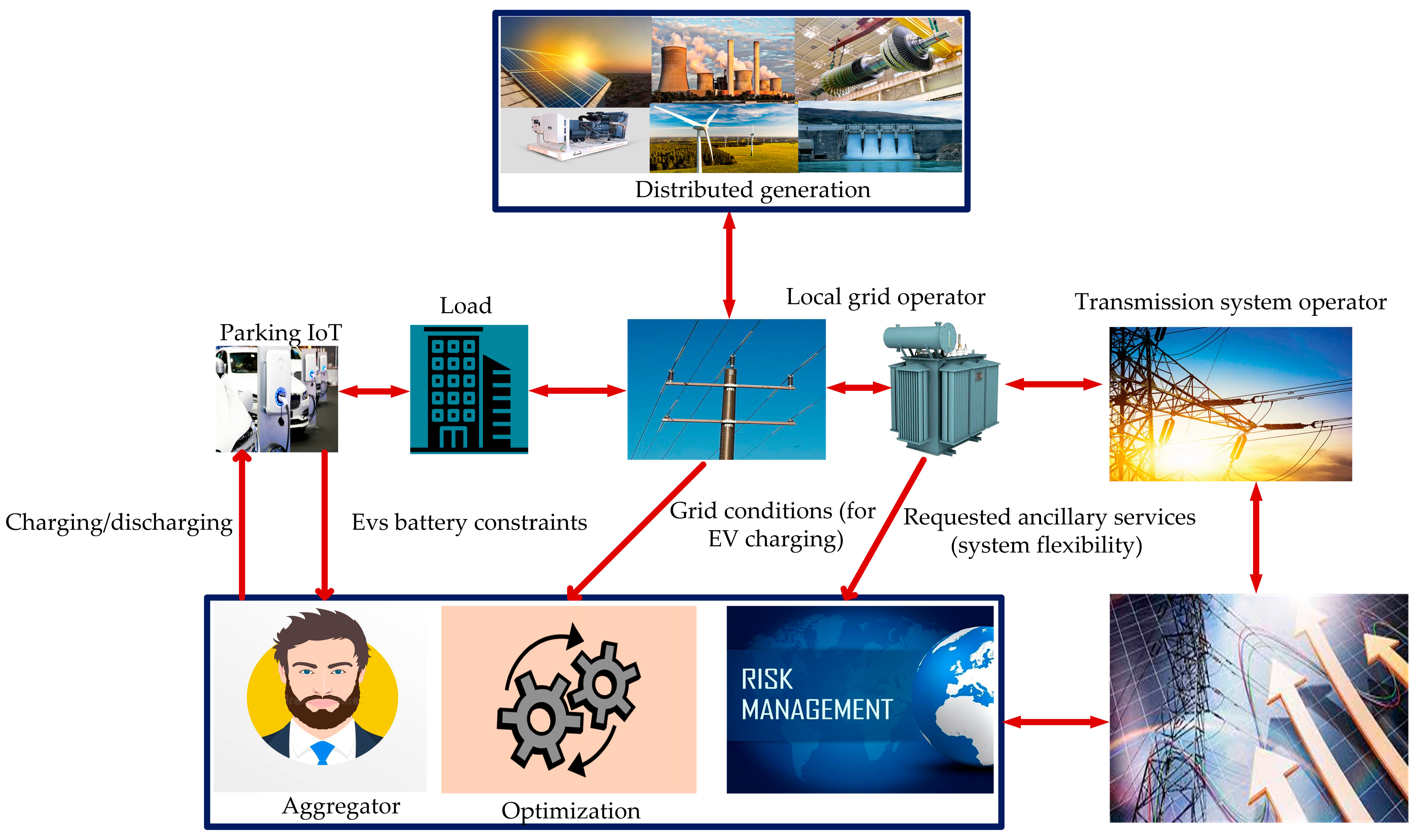
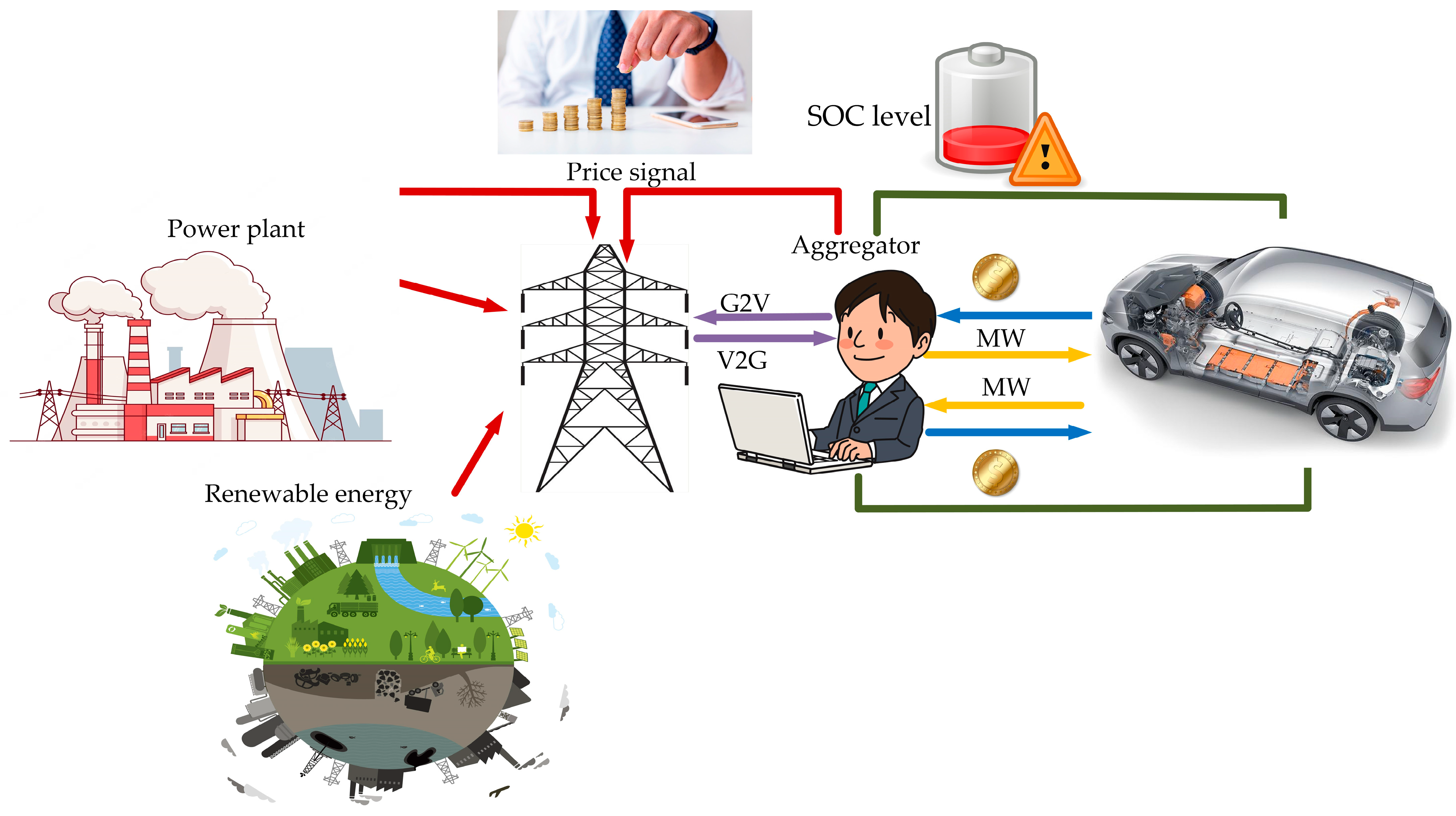
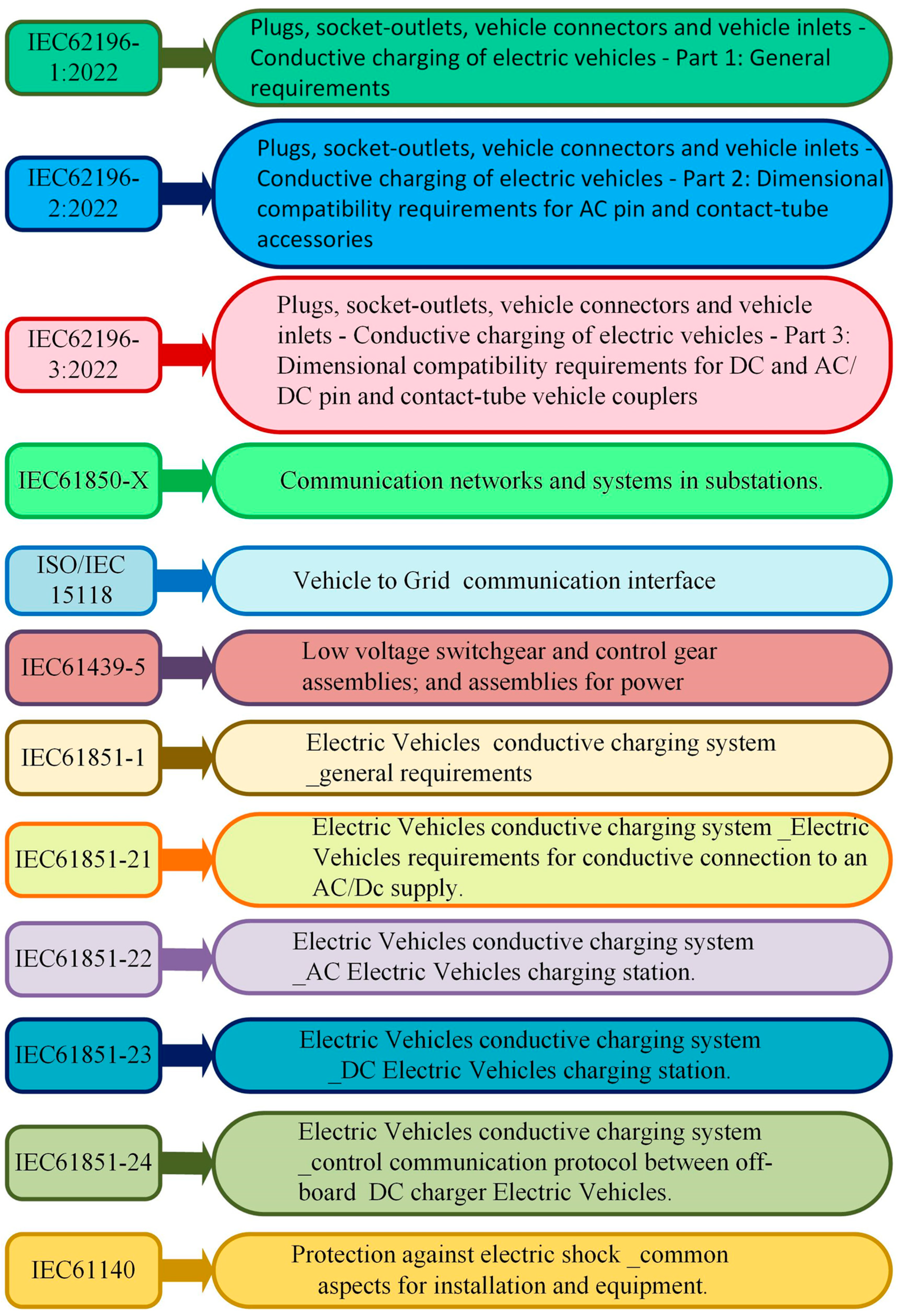
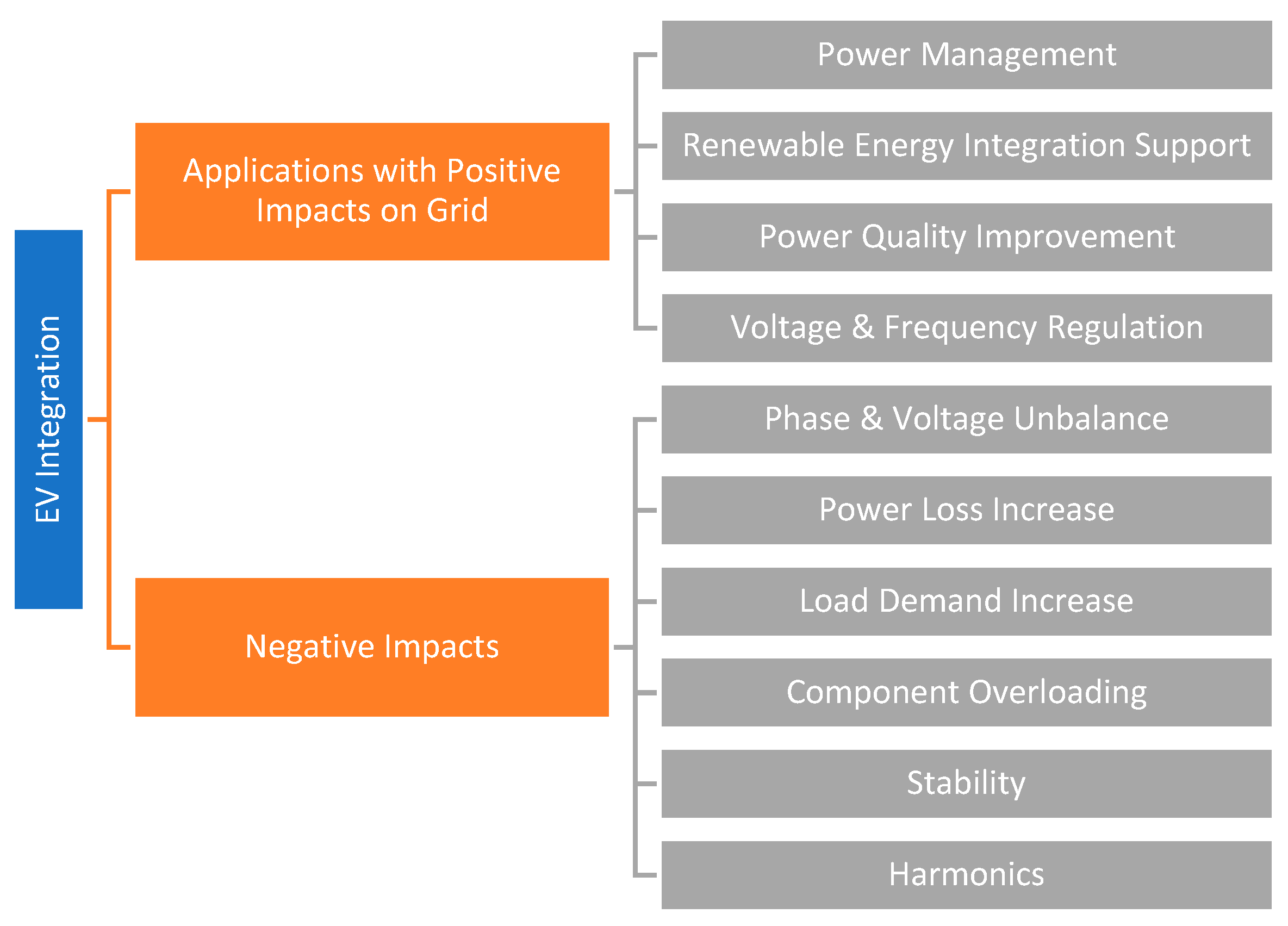
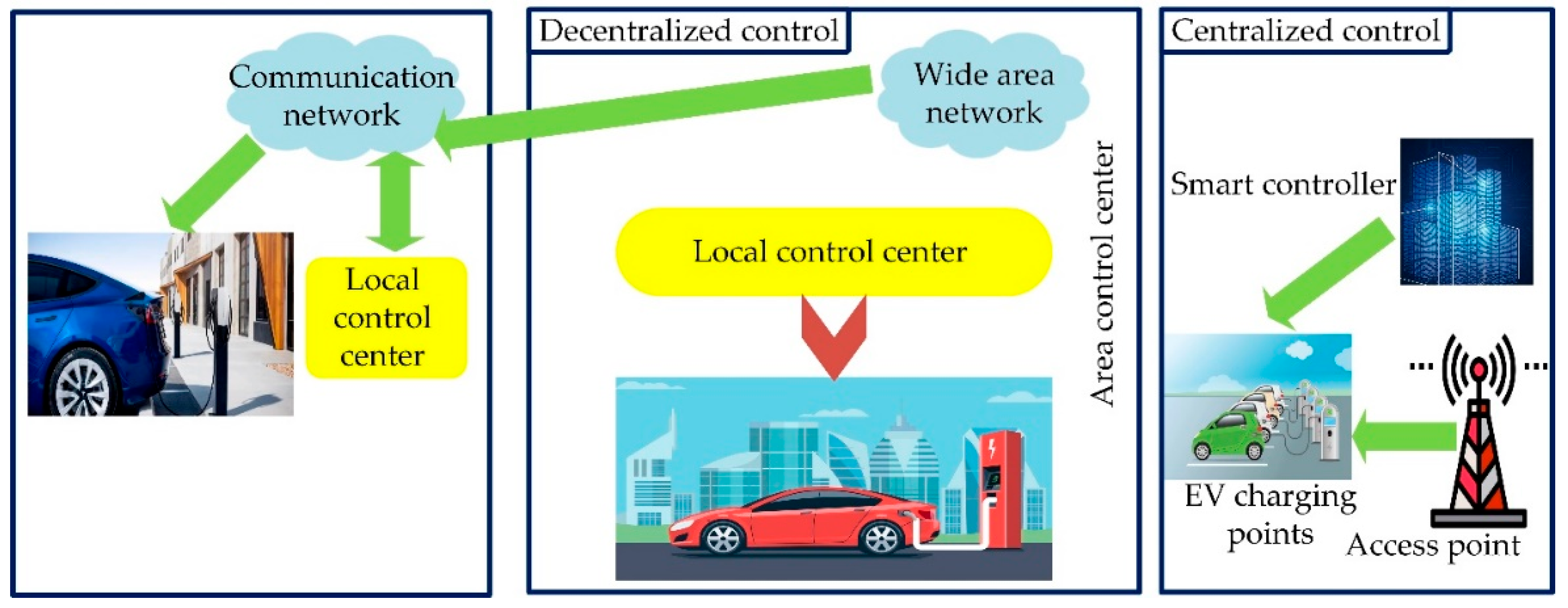
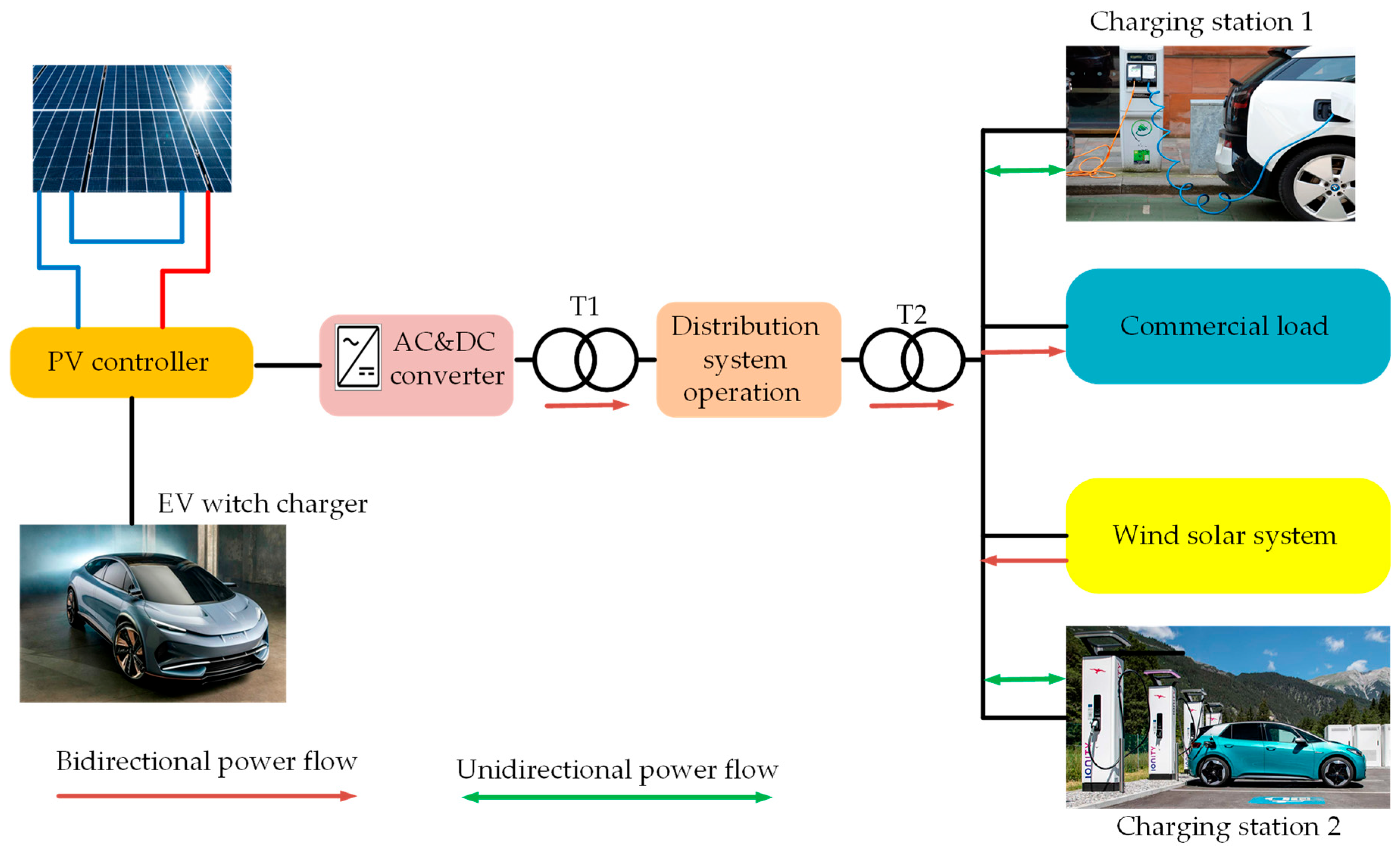

| EV Model | Type | Capacity | Charging Rate | Range | Cost | Production | Body Style |
|---|---|---|---|---|---|---|---|
| Nissan Leaf | BEV | 30 KWh | 6.5 KW | 107 miles | $29,000 | 2010–present | 5-door hatchback |
| Tesla Model S | BEV | 100 KWh | 10 KW | 316 miles | $71,000 | 2012–present | 5-door sedan liftback |
| Chevrolet Bolt | BEV | 60 KWh | 7.5 KW | 238 miles | $37,000 | October 2016–August 2021 | 5-door hatchback |
| Toyota Prius | PHEV | 10 KWh | 3.4 KW | 26 miles | $29,000 | December 1997–present | 4-door sedan (1997–2003) and 5-door liftback (2003–present) |
| Ford Fashion Energy | PHEV | 8 KWh | 3.4 KW | 19 miles | $34,000 | 2008–2020 | 4-door sedan |
| Specification | Level 1 | Level 2 | DC Fast Charging |
|---|---|---|---|
| Charging power | 1.44 kW–1.9 kW | 3.1 kW–19.2 kW | 120 kW–240 kW |
| AC or DC type of EV charging | AC | AC | DC |
| The amount of AC supply voltage | Single phase and 120/230 V | Split phase and 208/240 V | Single phase and 300/600 V |
| Current rate | 12 to 17 A | 15 to 82 A | 420 A |
| Charge location | Residential | Private and commercial | Commercial |
| Unit cost range per (single port) | $300–$1500 | $400–$500 | $10,000–$40,000 |
| Battery capacity | 15–50 kW | 15–50 kW | 15–50 kW |
| Charging time | 10–15 h | 3.5–8 h | 10–30 min |
| Charge model | On-board and slow-charging model | On-board and semi-fast charging model | Off-board and fast-charging model |
| EV Controller Type | Advantages | Disadvantages |
|---|---|---|
| Centralized | Energy market on a much larger scale; Wide geographical reach; Ability to implement in real time; High profit; Different ancillary services are possible. | Very expensive; Complex communication infrastructure; Complex data to process; Compromises privacy. |
| Decentralized | Simple communication infrastructure; High flexibility; Enhanced fault tolerance; Scalable; Compatible with EV fleet applications; Compatible with energy management applications. | Limitation on ancillary services; Due to the limitation in ancillary services, profit is low; Uncertainty in the result. |
| Battery Type | Cell Voltage (V) | Energy Congestion (Wh/L) | Determined Power (Wh/kg) | Cycle | Operation Temperature (°C) |
|---|---|---|---|---|---|
| Pb-PbO2 | 2.1 | 60–100 | 75–100 | 500–800 | −20–45 |
| Ni-Cd | 1.35 | 60–150 | 120–150 | 2000 | 0–50 |
| Ni-MH | 1.35 | 100–300 | 250–1000 | 500 | 0–50 |
| Zn-Br2 | 1.79 | 60–70 | 80–100 | >2000 | 20–40 |
| Na-S | 2.08 | 120–130 | 150–290 | 2500–4500 | 300–350 |
| Li-ion | 3.6 | 200–735 | 350–3000 | 400–3000 | −20–60 |
Disclaimer/Publisher’s Note: The statements, opinions and data contained in all publications are solely those of the individual author(s) and contributor(s) and not of MDPI and/or the editor(s). MDPI and/or the editor(s) disclaim responsibility for any injury to people or property resulting from any ideas, methods, instructions or products referred to in the content. |
© 2023 by the authors. Licensee MDPI, Basel, Switzerland. This article is an open access article distributed under the terms and conditions of the Creative Commons Attribution (CC BY) license (https://creativecommons.org/licenses/by/4.0/).
Share and Cite
Tarafdar-Hagh, M.; Taghizad-Tavana, K.; Ghanbari-Ghalehjoughi, M.; Nojavan, S.; Jafari, P.; Mohammadpour Shotorbani, A. Optimizing Electric Vehicle Operations for a Smart Environment: A Comprehensive Review. Energies 2023, 16, 4302. https://doi.org/10.3390/en16114302
Tarafdar-Hagh M, Taghizad-Tavana K, Ghanbari-Ghalehjoughi M, Nojavan S, Jafari P, Mohammadpour Shotorbani A. Optimizing Electric Vehicle Operations for a Smart Environment: A Comprehensive Review. Energies. 2023; 16(11):4302. https://doi.org/10.3390/en16114302
Chicago/Turabian StyleTarafdar-Hagh, Mehrdad, Kamran Taghizad-Tavana, Mohsen Ghanbari-Ghalehjoughi, Sayyad Nojavan, Parisa Jafari, and Amin Mohammadpour Shotorbani. 2023. "Optimizing Electric Vehicle Operations for a Smart Environment: A Comprehensive Review" Energies 16, no. 11: 4302. https://doi.org/10.3390/en16114302
APA StyleTarafdar-Hagh, M., Taghizad-Tavana, K., Ghanbari-Ghalehjoughi, M., Nojavan, S., Jafari, P., & Mohammadpour Shotorbani, A. (2023). Optimizing Electric Vehicle Operations for a Smart Environment: A Comprehensive Review. Energies, 16(11), 4302. https://doi.org/10.3390/en16114302






